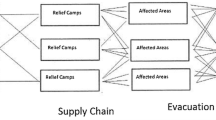Abstract
Supply chain planning during disasters can be challenging due to uncertainty in demand and travel time, leading to limited stocks and delivery delays. While previous studies have focused on network planning for disaster relief supply chains under uncertainty, they have not fully integrated all network components while considering various potential factors. This integration is crucial for successful humanitarian relief operations. To address this issue, we propose a comprehensive model using a two-stage mixed-integer stochastic linear programming. The model incorporates facility location, pre-positioning, direct allocation, and multi-depot vehicle routing under demand and travel time uncertainties while examining multi-echelon, multi-commodity, response deadlines, and deprivation costs. We also create an improved random forest algorithm to enhance the accuracy of demand and travel time forecasts. To obtain accurate information for effective decision-making, we develop a data-driven, exact algorithm by combining an improved random forest algorithm and Benders decomposition. Computational experiments show that our proposed algorithm outperforms the L-shaped method in finding a better solution with less running time. We provide a real case to validate our model and algorithms. Our model and solution scheme can help improve efficiency and timeliness while minimizing deficiencies in disaster relief efforts.





Similar content being viewed by others
References
Abazari, S. R., Aghsami, A., & Rabbani, M. (2021). Prepositioning and distributing relief items in humanitarian logistics with uncertain parameters. Socio-Economic Planning Sciences, 74, 100933.
Agarwal, S., Kant, R., & Shankar, R. (2022). Humanitarian supply chain management: modeling the pre and post-disaster relief operations. International Journal of Disaster Resilience in the Built Environment, 13(4), 421–439.
Aghajani, M., Ali Torabi, S., & Altay, N. (2023). Resilient relief supply planning using an integrated procurement-warehousing model under supply disruption. Omega (Oxford), 118, 102871.
Banomyong, R., Varadejsatitwong, P., & Oloruntoba, R. (2019). A systematic review of humanitarian operations, humanitarian logistics and humanitarian supply chain performance literature 2005 to 2016. Annals of Operations Research, 283(1–2), 71–86.
Bradter, U., Altringham, J., Kunin, W., Thom, T., O’Connell, J., & Benton, T. (2022). Variable ranking and selection with random forest for unbalanced data. Environmental Data Science, 1, E30.
Caroe, C. C., & Tind, J. (1998). L-shaped decomposition of two-stage stochastic programs with integer recourse. Mathematical Programming, 83, 451–464.
Chen, D. (2020). Prepositioning network design for disaster reliefs: Stochastic models and \(\Psi \)-expander models comparison. Computers & Industrial Engineering, 140, 106214.
Chiappetta Jabbour, C. J., Sobreiro, V. A., de Sousa, Lopes, Jabbour, A. B., de Souza Campos, L. M., Mariano, E. B., & Renwick, D. W. S. (2019). An analysis of the literature on humanitarian logistics and supply chain management: Paving the way for future studies. Annals of Operations Research, 283(1–2), 289–307.
China Meteorological Administration. (2019). Tropical cyclone size dataset. Downloaded from https://tcdata.typhoon.org.cn/en/tcsize.html. June 20, 2019.
Choukolaei, H. A., Ghasemi, P., & Goodarzian, F. (2023). Evaluating the efficiency of relief centers in disaster and epidemic conditions using multi-criteria decision-making methods and GIS: A case study. International Journal of Disaster Risk Reduction, 85, 103512–103512.
Donmez, Z., Kara, B. Y., Karsu, O., & Saldanha-da-Gama, F. (2021). Humanitarian facility location under uncertainty: Critical review and future prospects. Omega, 102, 102393.
Ghasemi, P., Goodarzian, F., & Abraham, A. (2022a). A new humanitarian relief logistic network for multi-objective optimization under stochastic programming. Applied Intelligence (Dordrecht, Netherlands), 52(12), 13729–13762.
Ghasemi, P., Goodarzian, F., Muñuzuri, J., & Abraham, A. (2022b). A cooperative game theory approach for location-routing-inventory decisions in humanitarian relief chain incorporating stochastic planning. Applied Mathematical Modelling, 104, 750–781.
Ghasemi, P., Khalili, H. A., Chobar, A. P., Safavi, S., & Hejri, F. M. (2022c). A new multiechelon mathematical modeling for pre- and postdisaster blood supply chain: Robust optimization approach. Discrete Dynamics in Nature and Society, 1–10.
Guo, P., & Zhu, J. (2023). Capacity reservation for humanitarian relief: A logic-based Benders decomposition method with subgradient cut. European Journal of Operational Research, 311(3), 942–970.
Gutjahr, W. J., & Fischer, S. (2018). Equity and deprivation costs in humanitarian logistics. European Journal of Operational Research, 270(1), 185–197.
Ha, N. T., Akbari, M., & Au, B. (2023). Last mile delivery in logistics and supply chain management: A bibliometric analysis and future directions. Benchmarking: An International Journal, 30(4), 1137–1170.
Haeri, A., Hosseini-Motlagh, S.-M., Samani, M. R. G., & Rezaei, M. (2020). A bi-level programming approach for improving relief logistics operations: A real case in Kermanshah earthquake. Computers & Industrial Engineering, 145, 106532.
Holguín-Veras, J., Pérez, N., Jaller, M., Van Wassenhove, L. N., & Aros-Vera, F. (2013). On the appropriate objective function for post-disaster humanitarian logistics models. Journal of Operations Management, 31(5), 262–280.
Hosseini, S., Ahmadi Choukolaei, H., Ghasemi, P., Dardaei-beiragh, H., Sherafatianfini, S., & Pourghader Chobar, A. (2022). Evaluating the performance of emergency centers during coronavirus epidemic using multi-criteria decision-making methods (case study: Sari City). Discrete Dynamics in Nature and Society, 2022, 1–13.
Jamali, A., Ranjbar, A., Heydari, J., & Nayeri, S. (2022). A multi-objective stochastic programming model to configure a sustainable humanitarian logistics considering deprivation cost and patient severity. Annals of Operations Research, 319(1), 1265–1300.
Katsaliaki, K., Galetsi, P., & Kumar, S. (2022). Supply chain disruptions and resilience: A major review and future research agenda. Annals of Operations Research, 319(1), 965–1002.
Khalili-Damghani, K., Tavana, M., & Ghasemi, P. (2022). A stochastic bi-objective simulation-optimization model for cascade disaster location-allocation-distribution problems. Annals of Operations Research, 309(1), 103–141.
Liu, Y., Lei, H., Wu, Z., & Zhang, D. (2019). A robust model predictive control approach for post-disaster relief distribution. Computers & Industrial Engineering, 135, 1253–1270.
Mahmoodi, A., Zergani, M. J., Hashemi, L., & Millar, R. (2022). Analysis of optimized response time in a new disaster management model by applying metaheuristic and exact methods. Smart and Resilient Transportation (Online), 4(1), 2242.
Ma, K., Yan, H., Ye, Y., Zhou, D., & Ma, D. (2022). Critical decision-making issues in disaster relief supply management: A review. Computational Intelligence and Neuroscience, 2022, 1–12.
Modarresi, S. A., & Maleki, M. R. (2023). Integrating pre and post-disaster activities for designing an equitable humanitarian relief supply chain. Computers & Industrial Engineering, 181, 109342.
Paciarotti, C., Piotrowicz, W. D., & Fenton, G. (2021). Humanitarian logistics and supply chain standards. Literature review and view from practice. Journal of Humanitarian Logistics and Supply Chain Management, 11(3), 550–573.
Pérez-Rodríguez, N., & Holguín-Veras, J. (2016). Inventory-allocation distribution models for postdisaster humanitarian logistics with explicit consideration of deprivation costs. Transportation Science, 50(4), 1261–1285.
Qi, M., Yang, Y., & Cheng, C. (2023). Location and inventory pre-positioning problem under uncertainty. Transportation Research. Part E, Logistics and Transportation Review, 177, 103236.
Ritchie, H., & Roser, M. (2014). Natural disasters. Published online at OurWorldInData.org. Retrieved from https://ourworldindata.org/natural-disasters.
Schonlau, M., & Zou, R. Y. (2020). The random forest algorithm for statistical learning. The Stata Journal, 20(1), 3–29.
Shao, J., Wang, X., Liang, C., & Holguín-Veras, J. (2020). Research progress on deprivation costs in humanitarian logistics. International Journal of Disaster Risk Reduction, 42, 101343.
Shapiro, A., & Nemirovski, A. (2005). On complexity of stochastic programming problems. In V. Jeyakumar & A. Rubinov (Eds.), Continuous optimization. Applied optimization. (Vol. 99). Boston, MA: Springer.
Shehadeh, K. S., & Tucker, E. L. (2022). Stochastic optimization models for location and inventory prepositioning of disaster relief supplies. Transportation Research. Part C, Emerging Technologies, 144, 103871.
Solomon, T., & Liu, Z. (2010). Earthquake induced damage classification for reinforced concrete buildings. Structural Safety, 32(2), 154–164.
Sun, H., Li, J., Wang, T., & Xue, Y. (2022). A novel scenario-based robust bi-objective optimization model for humanitarian logistics network under risk of disruptions. Transportation Research. Part E, Logistics and Transportation Review, 157, 102578.
Tofighi, S., Torabi, S., & Mansouri, S. (2016). Humanitarian logistics network design under mixed uncertainty. European Journal of Operational Research, 250, 239–250.
Wang, Y., Dong, Z. S., & Hu, S. (2021). A stochastic prepositioning model for distribution of disaster. Supplies considering lateral transshipment. Socio-Economic Planning Sciences, 74, 100930.
Wang, Z., Lai, C., Chen, X., Yang, B., Zhao, S., & Bai, X. (2015). Flood hazard risk assessment model based on random forest. Journal of Hydrology, 527, 1130–1141.
Wankmüller, C., & Reiner, G. (2020). Coordination, cooperation and collaboration in relief supply chain management. Journal of Business Economics, 90(2), 239–276.
Zhang, L., & Cui, N. (2021). Pre-positioning facility location and resource allocation in humanitarian relief operations considering deprivation costs. Sustainability (Basel, Switzerland), 13(8), 4141.
Zhang, G., Jia, N., Zhu, N., He, L., & Adulyasak, Y. (2023). Humanitarian transportation network design via two-stage distributionally robust optimization. Transportation Research. Part B: Methodological, 176, 102805.
Zhang, J., Liu, Y., Yu, G., Shen, Z., & Max. (2021). Robustifying humanitarian relief systems against travel time uncertainty. Naval Research Logistics, 68(7), 871–885.
Zhu, J., Shi, Y., Venkatesh, V. G., Islam, S., Hou, Z., & Arisian, S. (2022). Dynamic collaborative optimization for disaster relief supply chains under information ambiguity. Annals of Operations Research, 1–27.
Acknowledgements
This research/work was supported by the Provost Fellows Program Grant (R32020030000000) at the University of Massachusetts Dartmouth, MA, USA. The author would like to express sincere gratitude to the editor and the two anonymous referees for their invaluable feedback and assistance in significantly enhancing the quality and clarity of this paper. Their constructive comments and thoughtful suggestions played a crucial role in shaping the final version.
Author information
Authors and Affiliations
Corresponding author
Additional information
Publisher's Note
Springer Nature remains neutral with regard to jurisdictional claims in published maps and institutional affiliations.
Rights and permissions
Springer Nature or its licensor (e.g. a society or other partner) holds exclusive rights to this article under a publishing agreement with the author(s) or other rightsholder(s); author self-archiving of the accepted manuscript version of this article is solely governed by the terms of such publishing agreement and applicable law.
About this article
Cite this article
Wang, G. Disaster relief supply chain network planning under uncertainty. Ann Oper Res 338, 1127–1156 (2024). https://doi.org/10.1007/s10479-024-05933-6
Received:
Accepted:
Published:
Issue Date:
DOI: https://doi.org/10.1007/s10479-024-05933-6




